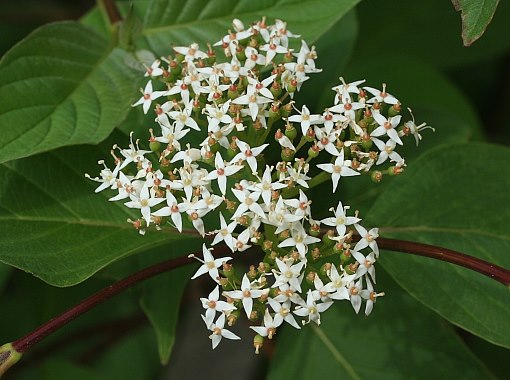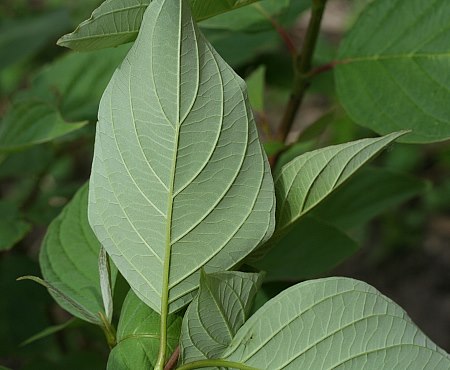Description: This shrub is 3-9' tall (rarely taller), developing multiple ascending stems from the ground. The basal stems branch outward toward along the upper portion of each shrub. The mature stems become woody; their bark is smooth, dark red, hairless, and shiny (less often it is yellow or brown). The bark is often covered with numerous white lenticels (air pores). Pairs of opposite leaves develop along the new growth of the stems. The leaf blades are 2-4" long and 1-3" across; they are ovate-lanceolate to ovate in shape and smooth along their margins. The upper surfaces of the leaf blades are medium green and hairless, while their lower surfaces are pale green. Depending on the local ecotype or variety, fine pubescence is sometimes present along the lower surfaces of the leaf blades.

Flat-headed panicles (or cymes) of white flowers occur among the leaves. These panicles span about 2-3" across. Individual flowers are ¼" across, consisting of a small green calyx with 4 narrow teeth, 4 white petals, 4 stamens, and a pistil with a single style. The petals are narrowly lanceolate and spread outward from the center of each flower. The blooming period occurs from late spring to early summer and sometimes later in the year. The flowers are fragrant. After the blooming period, the flowers are replaced by globoid drupes (one-seeded berries) up to 1/3" (8 mm.) across that become white at maturity. Each fleshy drupe contains a single large seed. The drupes are mildly bitter and sour. The woody root system is branching and shallow. Clonal offsets are often produced from either underground runners or above ground stolons, resulting in colonies of shrubs.
Cultivation: The preference is full sun to partial shade, moist conditions, and soil that is loamy, silty, or sandy. This shrub develops fairly quickly and tolerates temporary flooding. It should not be located at sites that are hot and dry.
Range & Habitat: The native Red-Osier Dogwood is occasional in the northern half of Illinois, while in the southern half of the state it is uncommon. It tends to be more common in sandy areas than non-sandy areas. Habitats include moist sandy thickets, shrub swamps, shrubby bogs, sandy areas along rivers, fens, interdunal swales, marshes, and sandy ditches. This shrub is often used as a landscaping plant and there are many cultivars available.
Faunal Associations: The nectar and pollen of the flowers attract many kinds of insects, including honeybees, bumblebees, Halictid bees, masked bees (Hylaeus), Andrenine bees, various wasps, Syrphid flies, Calliphorid flies, Muscid flies, butterflies, and various beetles (Lovell, 1898; Lovell, 1915; Gosling, 1986; Voss, 1954). Other insects feed on the foliage, plant sap, and other parts of Red-Osier Dogwood. These insects include leaf beetles (including flea beetles), larvae of gall flies (Cecidomyiidae), plant bugs (Miridae), aphids, a leafhopper (Erythroneura rubrella), the Dogwood Scurfy Scale (Chionaspis corni) and other armored scales, larvae of various moths, and larvae of a butterfly, the Spring Azure (Celastrina ladon); see Insect Table. Examples of aphids that feed on this shrub are the Dogwood-Grass Aphid (Anoecia corni), Dogwood-Sunflower Aphid (Aphis carduella), and Dogwood-Fireweed Aphid (Aphis salicariae). Among vertebrate animals, birds that feed on the fruits include some sparrows, finches, catbirds and thrashers, upland gamebirds, woodpeckers, thrushes, and kingbirds. The Bird table provides a more detailed list of these species. Mammals that feed on various parts of Red-Osier Dogwood include the American Moose (foliage, twigs), Cottontail Rabbit (bark), and American Black Bear (fruit); see Martin et al. (1951/1961), Noyce & Coy, 1990, Mosnier et al. (2008), and Romain et al. (2013). Other mammals that are known to feed on dogwood shrubs (Cornus spp.) include the White-tailed Deer (foliage, twigs), White-footed Mouse (fruits), and American Beaver (wood, bark). Red-Osier Dogwood also provides protective cover for some birds and small mammals.
Photographic Location: On the grounds of the Independent Media Center in Urbana, Illinois.

Comments: Because of its attractive woody stems, Red-Osier Dogwood is one of the more attractive Cornus spp. (Dogwood shrubs), particularly during the winter. Because of these showy stems, it is fairly easy to identify. Other Dogwood shrubs with white berries include Cornus racemosa (Gray Dogwood) and Cornus drummondii (Rough-Leaved Dogwood). Gray Dogwood has gray or brown twigs, while the young shoots and leaves of Rough-Leaved Dogwood are more hairy than those of Red-Osier Dogwood. There is a variety of Red-Osier Dogwood, var. baileyi, that is found in the sand dune region along Lake Michigan. In contrast to the typical variety (described above), this variety has leaf undersides with appressed pubescence and its stems are more brown. A scientific synonym of Red-Osier Dogwood is Cornus stolonifera.